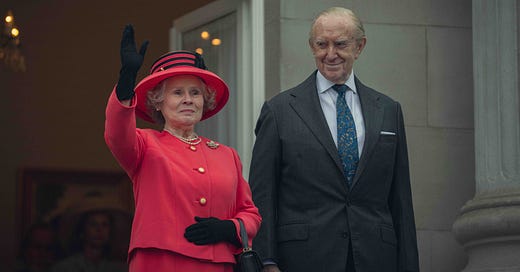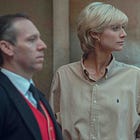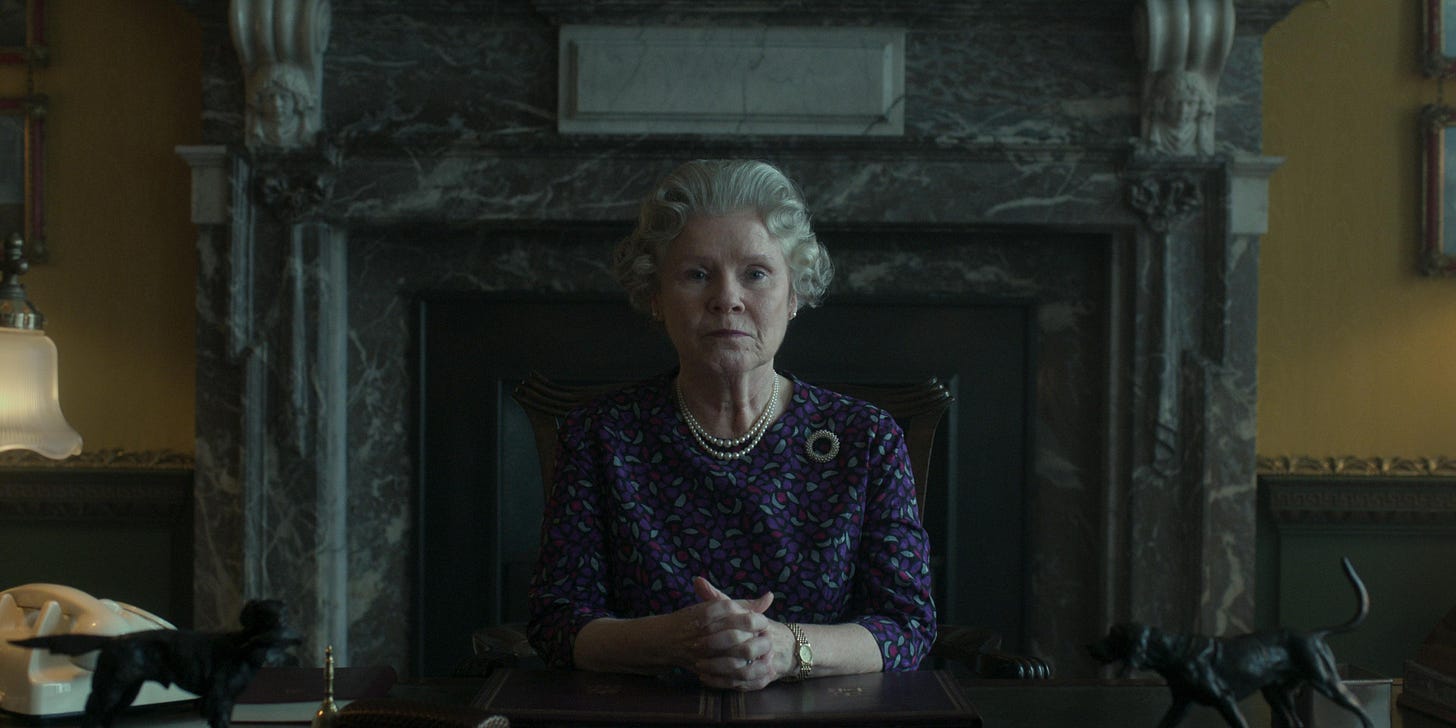‘The Crown’ Comes to a Close
Sally Bedell Smith on what to watch for in the final episodes of the blockbuster dramatization of the British Royal Family.
Here. We. Go! The final six episodes of Netflix’s award-winning series, The Crown, arrive tomorrow. Creator Peter Morgan has taken us on quite a journey these last seven years, hasn’t he? The show began with then-Princess Elizabeth’s wedding in 1947 and will end nearly six decades later, around the wedding of Prince Charles and Camilla Parker Bowles in 2005.
What will these last episodes include? For some predictions, I turned
, the best-selling author who is extremely well-versed on this stretch in royal history. Her many books include a pair of must-read royal biographies, 2012’s Elizabeth the Queen: The Life of a Modern Monarch and 2017’s Prince Charles: The Passion and the Paradoxes of an Improbable Life . SMT readers may also recall our conversation from earlier this year about her latest book, George VI and Elizabeth: The Marriage that Saved the Monarchy. Bedell Smith has joined Substack now, too! Check out , where she offers insightful and deeply informed looks at important moments in royal history.In our chat, Bedell Smith summarized what major royal moments from these eight years we could see, including the deaths of Princess Margaret and the Queen Mum, as well as why Queen Elizabeth II was photographed at McDonald’s and what Joan Rivers had to say about Charles and Camilla’s wedding. She also shared her thoughts on the long-term impact of The Crown’s dramatization and how the series may come to a close. (No spoilers here! We talked after the release of Part 1 but before Bedell Smith watched Part 2.)
But first! For more on Will and Kate’s origin story this season — or rather, The Crown’s spin on the earliest days of their courtship — check out my Town & Country digital cover here. I sat down with actors Ed McVey and Meg Bellamy, who shared where they were before The Crown and what they learned from these royal roles.
🎧 SMT x The Crown Podcast
If you haven’t had a chance to listen yet, now is the time! My Substack-exclusive podcast, So Many Thoughts on The Crown, is a one-stop shop for the final season. Along with a preview of Part 1 and Part 2, I have done episode-by-episode recaps complete with my reactions, reflections, and some fact-checking of the major storylines. I’ll be rolling out my Part 2 takes this week.
PS: The podcast is available to paid subscribers only. I’m running a Crown special this week — get 20% annual subscriptions! You’ll also get access to our discussion threads and the comment section. More details below.
’The Crown’ Final Season Primer with Sally Bedell Smith
Please note: This conversation has been edited and condensed.
Sally, it’s so nice to chat again. Before we get into Part 2, I want to rewind to Part 1. What did you make of the first half of Season 6 and how Diana’s death was handled?
Sally Bedell Smith: As has been the case throughout the series, but probably wasn’t as noticeable at the beginning, you have very strong lines of fact and fiction intermingling.
It was odd to have four episodes devoted to this very brief period of time. I think it unnecessarily distorted it. It wasn’t even eight weeks; the actual romance was less than a month. Everybody who was around then knew what was playing out in the tabloids. [Peter Morgan] sort of went overboard by inventing various things, like Camilla’s 50th birthday party right off the bat. That birthday party obviously happened, but including Princess Margaret in it and having her call the queen and tell her that she should be nicer to Camilla — it was absolutely nothing like what actually happened. [EH note: For Bedell Smith’s full fact check of Part 1, check out her spread in The Times here.]
I would like to take a bit step back and get your thoughts on what Peter Morgan has done here. As somebody steeped in this world, I’m curious what you make of The Crown and the effect it has had on the real-life Windsors.
[The Crown] has spent so much time and money devoted to the visual details of the production that it imprints on people that this actually happened. People will come away from this with a take on royal history — going back all the way to the 1950s — with a view that is often at odds with what really happened.
That’s dispiriting for people like me, who try to get the facts, who try to write the history with good, solid sourcing, who do try to get it right.
I have maintained for a while that I think they could have clarified what they were doing and guided the viewer by putting a disclaimer at the beginning, which they sort of stuck into Season 5. I didn’t see it in Season 6. It would have put viewers on notice that they really should not take this as having happened; some of it did and some of it didn’t.
You have worked with Peter Morgan on earlier projects, is that right? What was that like?
I was a consultant on a TV movie about [President Bill] Clinton and [Prime Minister Tony] Blair called The Special Relationship [written by Peter Morgan] and then on The Audience, his stage play with Helen Mirren. With a stage play, the audience is required to suspend disbelief. You know that what you’re watching has been made up. It’s a very different viewing experience.
I was very impressed with [Morgan]. He is a brilliant man and a wonderful writer. I had written my book about the queen by then, and he relied on me to talk about what would be in-character for this situation. I was very comfortable with that.
But then The Crown did something very different, which was to have the most extraordinary production values and these incredible actors. It became something that didn’t require you to suspend disbelief. It required you to be pulled in and to believe everything you were seeing.
Has the believability changed as the series progressed?
At the beginning, all the players were so dazzling and so beautiful. Most people [watching] weren’t around then and I think people got carried away and said, “Well, yes, this must have happened.” But of course, there were plenty of fictitious aspects in the early seasons.
One of the more disturbing things that they did was the incident where Phillip’s sister was killed in a plane crash. [On The Crown] he was made to seem as if he was at fault because he had misbehaved in school and they had flown to London. Nothing of the sort happened. They were flying to London to go to a family wedding. It was very, very cruel to him because he adored his sister.
There were more innocuous things, too, that were totally fictitious, like the London Fog episode where Churchill had a secretary who was hit by a bus and killed. I looked through any number of Churchill biographies — which we have many — and there was nothing.
There are a lot of these dramatic devices, for better or for worse, that convey things that Peter Morgan wanted to present, wanted to highlight.
Let’s talk about what actually happened in the years Season 6, Part 2 will cover, from 1997 to 2005. I would like to focus on the monarch and her heir. What did Elizabeth II’s reign look like at this time?
She was obviously dealing with the aftermath of Diana’s death, really trying to figure out: What are the lessons learned? They had polling and brought in communications directors, very different sorts of people from those who had run the Buckingham Palace Press office before. They were polished public relations professionals, determined to — not erode the magic — but present the queen in a more accessible way.
The queen incrementally adjusted. She put herself in situations where she was shown to be a little more demonstrative. Not necessarily talking about her feelings, but instead of viewing things from a distance, she would go into a classroom and sit down and talk to the children. They went overboard once, where she drove up to a McDonald’s in her Bentley, which may end up in The Crown.
Other events we could see: November of 1997 was Elizabeth and Philip’s golden wedding anniversary. In 1999, Prince Edward married Sophie. The Crown has already dealt with the decommissioning of the Britannia, but that actually occurred after Diana’s death.
One thing that was hanging over the queen from 1998 to 2002 was the decline of her sister and her aging mother. This was an extraordinary year, 2002, because it was the queen’s Golden Jubilee, marking 50 years on the throne. She was 76, older than Charles is now. First, she loses her sister in February. Six weeks later, she loses her mother at the age of 101.
She went to Westminster Hall for the lying-in-state of her mother. On the way back something very unusual happened. The crowd began to clap for her. It was an emotional turning point for the queen—and for the people. She had now become not only admired, but beloved. Her mother, the Queen Mum, had always been the grandmother of the nation, the beloved one. And now it was the queen.
It will be interesting to see how, or if, The Crown does that, because it was a crucial moment.
Let’s turn to Charles and Camilla. A lot happened in their relationship in the years The Crown is about to cover. Where do you think we will find Charles after Diana’s death?
Initially, he and the boys retreated to Highgrove. Camilla, needless to say, absolutely disappeared. In a few weeks, Charles had an event in Manchester, and he spoke with some emotions about what had happened, which I think was good for him. Then he went with Harry to South Africa — I can’t remember in Spare, Harry may have a different view of it — but [the trip] was viewed as evidence that Charles was taking fatherhood seriously.
All along, insofar as Charles was concerned, they resumed Operation PB, which was the rehabilitation of Camilla Parker Bowles. Camilla was still very much behind the scenes. In 1998, she started to appear at private events that Charles hosted. That summer, she was introduced to William and then later to Harry. There was a kerfuffle over the story leaking, but there was movement forward. The first visible evidence of that was Charles’s 50th birthday party at Highgrove, which, in fact, Princess Margaret did attend, as did William and Harry.
What do you think we will see of their relationship becoming public?
Fast forward to January of 1999, there was a very well-orchestrated appearance of Camilla and Charles coming out of the Ritz Hotel. It was so meticulously planned: They would walk out and there would be photographs. Up until then, they had been ducking around trying to avoid being photographed because they knew that whoever photographed them together would get a huge payoff. They wanted to normalize being together.
I don’t think The Crown will show this, but I wrote in my book about a fascinating trial balloon for Camilla when she went to New York. She had her coming out there, went to the theater and was hosted at a lunch. [EH note: Bedell Smith also wrote about this on her Substack,
, in a fascinating post you can find here.]One thing I think they will have to include is what happened in June of 2000, when Camilla was reintroduced to the queen — reintroduced, because she had met her years earlier — at a barbecue for Charles’s cousin, King Constantine, the former king of Greece. It was an important moment. As somebody said, “A cracking of the ice.” It wasn’t full acceptance; she was not ready to embrace Camilla. But she was willing to acknowledge her.
We know that we will see their 2005 wedding in some capacity. Any predictions on how it will be handled?
It’s hard to imagine that they could portray it in any kind of a downbeat way because it was a moment of triumph, really, for Charles and Camilla. It took a lot of maneuvering with the church, figuring out how they could do it and what was permitted constitutionally, what was permitted by the Church of England. They came up with a compromise — it was really quite elegant — that they would have the small ceremony in the Windsor Town Hall and then they would have this much larger service in St. George’s Chapel.
I remember talking to Joan Rivers, of all people, she was there and she said, “I go to so many weddings and there’s all kinds of backbiting and criticism. Everybody was happy!”
And the queen gave that wonderful speech, comparing Charles and Camilla to overcoming the hurdles at the Grand National, which was just kind of perfect. She ended it by saying, “My son is home and dry with the woman he loves.”
If [The Crown] ends on that note, it won’t necessarily negate the various calumnies and mischaracterizations and inventions threaded through the previous seasons, but at least it will lead viewers with a good feeling. And I think that’s probably important for the series.
My thanks to
! Make sure to check out her Substack, for delightful deep dives into royal history.💭 Any predictions for Season 6, Part 2? Share them in the comments of this newsletter!
🗣️ Keep me posted on your Crown thoughts as you dive in this week. Record a voice memo on your phone with your reaction, reflections and questions. Then email it to me at Hello@SoManyThoughts.com. Make sure to include your name and where you are from — I might just include it in a future podcast…!
🎁 If you still have a lot of holiday shopping to do (I know I do!), check out the 2023 So Many Thoughts Gift Guide. There are three parts: Things I love, things you all love (a spreadsheet of choices!), and things small businesses from the SMT community love to make.














Thank you so much, Sally! I loved chatting with you, very much appreciate your insights.
This was such a fascinating read! I can’t wait for the new season and your commentary.